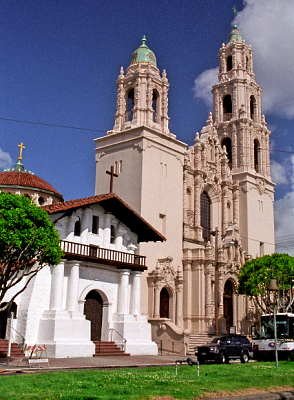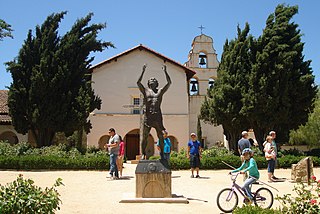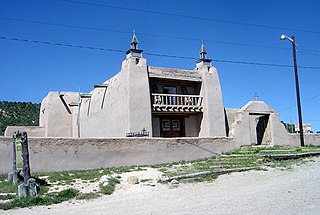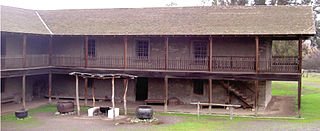
Juan Bautista de Anza Bezerra Nieto was an expeditionary leader, military officer, and politician primarily in California and New Mexico under the Spanish Empire. He is credited as one of the founding fathers of Spanish California and served as an official within New Spain as Governor of the Province of New Mexico.

Mission San Francisco de Asís, commonly known as Mission Dolores, is a Spanish Californian mission and the oldest surviving structure in San Francisco. Located in the Mission District, it was founded on October 9, 1776, by Padre Francisco Palóu and co-founder Fray Pedro Benito Cambón, who had been charged with bringing Spanish settlers to Alta California and with evangelizing the local indigenous Californians, the Ohlone. The present mission building was the second structure for the site and was dedicated in 1791.

Mission San Juan Bautista is a Spanish mission in San Juan Bautista, San Benito County, California. Founded on June 24, 1797 by Fermín Lasuén of the Franciscan order, the mission was the fifteenth of the Spanish missions established in present-day California. Named for Saint John the Baptist, the mission is the namesake of the city of San Juan Bautista.

San Juan Bautista is a city in San Benito County, in the U.S. state of California. The population was 2,089 as of the 2020 census. San Juan Bautista was founded in 1797 by the Spanish under Fermín de Lasuén, with the establishment of Mission San Juan Bautista. Following the Mexican secularization of 1833, the town was briefly known as San Juan de Castro and eventually incorporated in 1896. Today, San Juan is a popular tourist destination, as the home of the San Juan Bautista State Historic Park and other important historic sites, as well as cultural institutions like El Teatro Campesino.

El Camino Real is a 600-mile (965-kilometer) commemorative route connecting the 21 Spanish missions in California, along with a number of sub-missions, four presidios, and three pueblos. Historically associated with the Calle Real which terminates in Mexico City, as the former capital of New Spain and the seat of royal power for Las Californias, its southern end in the modern U.S. state of California is at Mission San Diego de Alcalá and its northern terminus is at Mission San Francisco Solano.

The Peralta Adobe, also known as the Luis María Peralta Adobe or the Gonzales-Peralta Adobe, is the oldest building in San Jose, California. The adobe was built in 1797 by José Manuel Gonzeles, one of the founders of San Jose, and is named after Luis María Peralta, its most famous resident.

The Juan Bautista de Anza National Historic Trail is a 1,210-mile (1,950 km) trail extending from Nogales on the U.S.-Mexico border in Arizona, through the California desert and coastal areas in Southern California and the Central Coast region to San Francisco. The trail commemorates the 1775–1776 land route that Spanish commander Juan Bautista de Anza took from the Sonora y Sinaloa Province of New Spain in Colonial Mexico through to Las Californias Province. The goal of the trip was to establish a mission and presidio on the San Francisco Bay. The trail was an attempt to ease the course of Spanish colonization of California by establishing a major land route north for many to follow. It was used for about five years before being closed by the Quechan (Yuma) Indians in 1781 and kept closed for the next 40 years. It is a National Historic Trail administered by the National Park Service and was also designated a National Millennium Trail.

Tumacácori National Historical Park is located in the upper Santa Cruz River Valley in Santa Cruz County, southern Arizona. The park consists of 360 acres (1.5 km2) in three separate units. The park protects the ruins of three Spanish mission communities, two of which are National Historic Landmark sites. It also contains the landmark 1937 Tumacácori Museum building, also a National Historic Landmark.

El Presidio Real de Santa Bárbara, also known as the Royal Presidio of Santa Barbara, is a former military installation in Santa Barbara, California, United States. The presidio was built by Spain in 1782, with the mission of defending the Second Military District in California. In modern times, the Presidio serves as a significant tourist attraction, museum and an active archaeological site as part of El Presidio de Santa Barbara State Historic Park.

José Antonio Castro was a Californio politician, statesman, and general who served as interim Governor of Alta California and later Governor of Baja California. During the Bear Flag Revolt and the American Conquest of California, Castro led Mexican forces as the Commandante General of Northern California.

The Juan de Anza House, also known as the Casa de Anza, is a historic adobe house in San Juan Bautista, California. Built around 1830, Casa de Anza is a well-preserved example of residential construction from the period of Mexican California. It was declared a National Historic Landmark in 1970.

The José Castro House, sometimes known as the Castro-Breen Adobe, is a historic adobe home in San Juan Bautista, California, facing the Plaza de San Juan. The Monterey Colonial style house was built 1838-41 by General José Antonio Castro, a former Governor of Alta California. It was later sold to the Breen family, who lived there until 1933, when the house became a museum as part of San Juan Bautista State Historic Park.

Warner's Ranch, near Warner Springs, California, was notable as a way station for large numbers of emigrants on the Southern Emigrant Trail from 1849 to 1861, as it was a stop on both the Gila River Trail and the Butterfield Overland Mail stagecoach line (1859-1861). It was also operated as a pioneering cattle ranch.

The San Jose de Gracia Church, also known as Church of Santo Tomas Del Rio de Las Trampas, is a historic church on the main plaza of Las Trampas, New Mexico. Built between 1760 and 1776, it is one of the least-altered examples of a Spanish Colonial Pueblo mission church, with adobe walls rising 34 feet (10 m) in height. It was declared a National Historic Landmark in 1970.

San Estévan del Rey Mission Church is a Spanish mission church in the Roman Catholic Diocese of Gallupon the Acoma Pueblo Reservation in western New Mexico. Built between 1629 and 1641, it is one of the finest extant examples of hybrid Spanish Colonial and Puebloan architectural styles. It was named for Saint Stephen I of Hungary. The church was declared a National Historic Landmark in 1970, and is listed on the National Register of Historic Places. It remains a mission church and is part of the parish of San José de la Laguna in Laguna, New Mexico.

The Larkin House is a historic house at 464 Calle Principal in Monterey, California. Built in 1835 by Thomas O. Larkin, it is claimed to be the first two-story house in all of California, with a design combining Spanish Colonial building methods with New England architectural features to create the popular Monterey Colonial style of architecture. The Larkin House is both a National and a California Historical Landmark, and is a featured property of Monterey State Historic Park.

Monterey Colonial is an architectural style developed in Alta California. Although usually categorized as a sub-style of Spanish Colonial style, the Monterey style is native to the post-colonial Mexican era of Alta California. Creators of the Monterey style were mostly recent immigrants from New England states of the US, who brought familiar vernacular building styles and methods with them to California.

El Pueblo de Los Ángeles Historical Monument, also known as Los Angeles Plaza Historic District and formerly known as El Pueblo de Los Ángeles State Historic Park, is a historic district taking in the oldest section of Los Angeles, known for many years as El Pueblo de Nuestra Señora la Reina de los Ángeles del Río de Porciúncula. The district, centered on the old plaza, was the city's center under Spanish (1781–1821), Mexican (1821–1847), and United States rule through most of the 19th century. The 44-acre park area was designated a state historic monument in 1953 and listed on the National Register of Historic Places in 1972.

Plaza Hotel in San Juan Bautista, California in San Benito County, is a California Historical Landmark No. 654 listed on March 6, 1935. The Plaza Hotel was built in 1813 as a adobe soldiers barracks by New Spain. The Spanish soldiers were stationed at the barracks to guard the Mission San Juan Bautista founded on June 24, 1797 by Fermín Lasuén. across the street. The Plaza Hotel building was built as a one-story building and later in the 1850s a second floor was added.





















